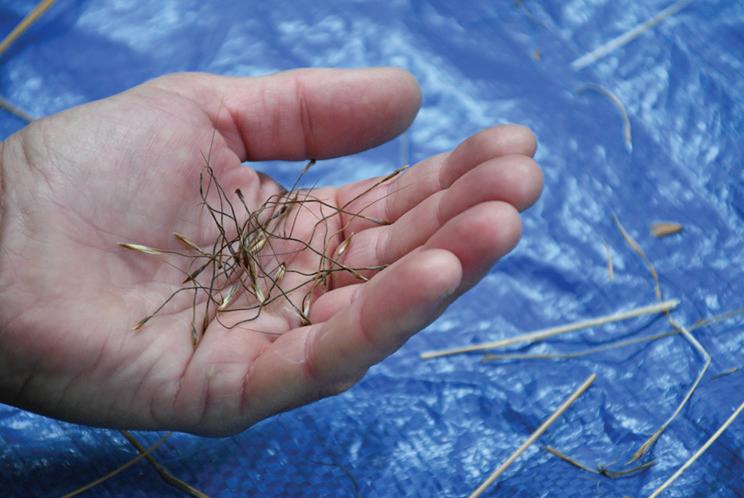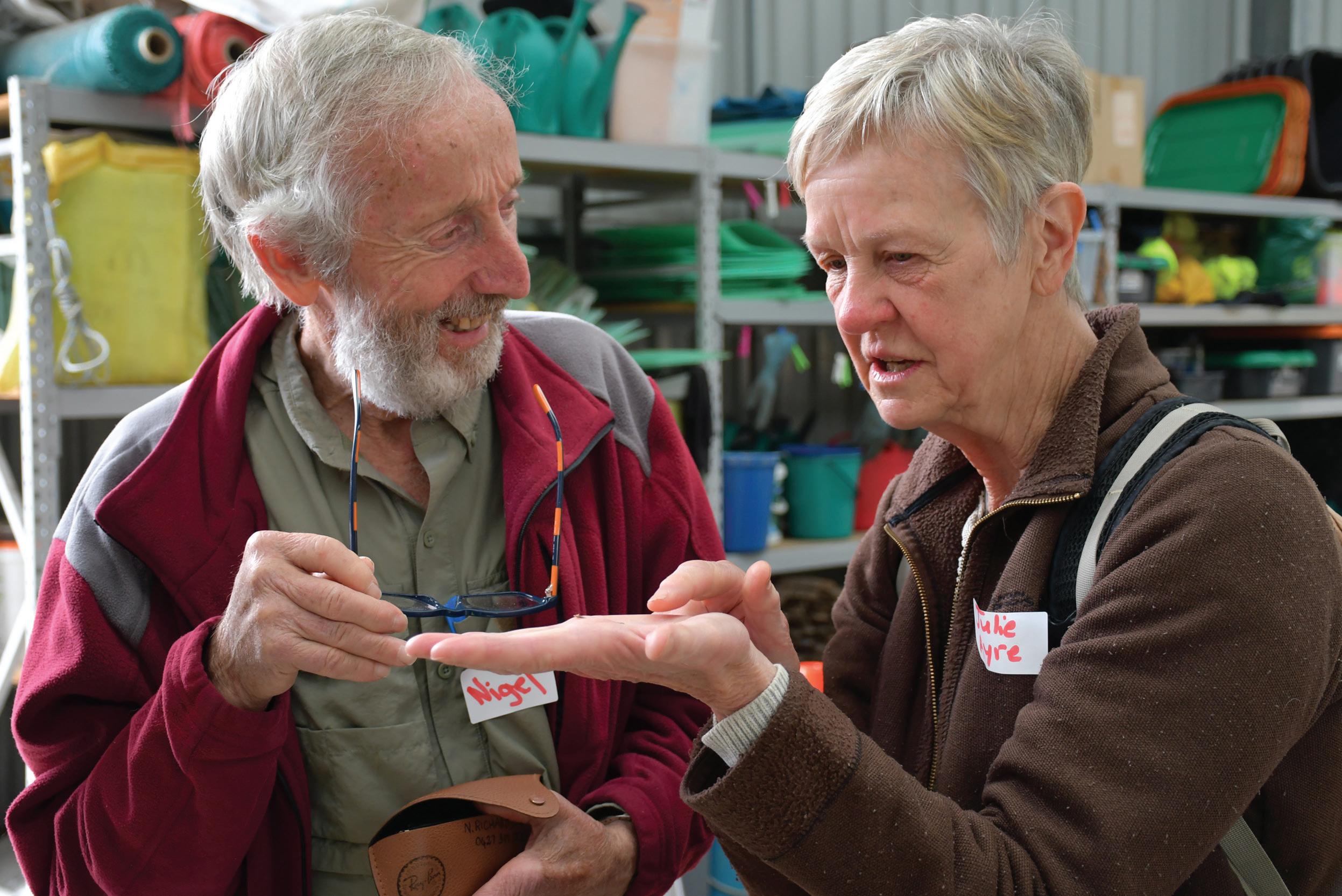STORY PAGES 4-5
hobartcity.com.au/bushcare


STORY PAGES 4-5
hobartcity.com.au/bushcare




I’m heading off the beaten track for this Bushcare Roundup by starting off with a report about climate change and art, rather than weeds!
Recently Mona Foma gave some of our Bushcare volunteers the chance to attend Climate Notes, a performance that used video and music as an expression and interpretation of handwritten letters from scientists describing how they feel about climate change.

Bushcare volunteers John and Maria Grist attended the event on our behalf and say the performance explored a full range of sounds, from ethereal meditative high notes to deeply resonating lows.
Letters from scientists recounting their hopes and fears for the future were flashed across the screen and the music ranged from sound for sound’s sake through to raw passion.
The idea of the two soloists playing along with themselves through the video was fascinating. Even the sounds of fossil fuels being burnt with abandon did not detract, but only added to the experience.
This fascinating performance was a reminder that scientists across the world continue their passionate work to discover, inform, support and protect our planet and the wonderful lifeforms of Earth.
Wow! 54 volunteers joined us on the mountain summit for our Clean-up kunanyi Day in January. What an effort! We bagged 71 kilograms of rubbish, sadly much of it cigarette butts.
We found all sorts of oddities, but the one that caught everyone’s eye was a little fairy castle. And what was a sand castle and spade
doing on our alpine summit? It was such a great event, the mountain was moody, and all of our volunteers carried big smiles with them.
And next time you are enjoying the views from the top of kunanyi/ Mt Wellington keep your eye out for litter. We can all do our bit to keep rubbish from ending up in this beautiful landscape.

Hobart’s Beaumaris Zoo on the Queens Domain, the last known residence of the Tasmanian tiger, is now home to another endangered native Tasmanian animal – bandicoots.
Jen Styger, the City of Hobart’s Program Leader Fire and Biodiversity, says a family of eastern barred bandicoots now lives in the blackberries at the old zoo site.
“Small marsupials like bandicoots really need bushes they can jump into and hide and be protected from predators,” she says.
“They also like to be near open grassy areas where they can forage for food, and so the fenced off bushland area on the old zoo site is proving perfect habitat for small animals like eastern barred bandicoots.
“Eastern barred bandicoots are listed as vulnerable to extinction in Australia, and so increasing their numbers is something we
The old zoo site is fenced off from dogs, giving both eastern barred bandicoots and brown bandicoots greater protection from roaming animals.
It has been a deliberate decision not to remove the blackberries within the old zoo site because of the role they now play in giving the eastern barred bandicoots shelter and protection.
This year marks the 100th anniversary of the zoo’s opening on the Domain. Local historian
Brendan Lennard says the first exotic animals to arrive at the zoo were lions from Taronga Zoo. A couple of years later an elephant arrived.
It was home to zebras, two polar bears, leopards, tigers and sun bears. Lion and leopard cubs were born at the zoo.
“I think there is a wonderful irony in that almost 80 years since the zoo closed it has actually become a sanctuary for native animals again,” he says.


The City of Hobart’s Backyard Bandicoots program helps residents learn about our eastern barred bandicoots – how to keep them safe and how to ensure you have a bandicoot friendly garden.
To learn more about the program, and how to become a “Bandicoot Buddy” by making your garden bandicoot friendly, visit hobartcity.com.au/ bandicoots
Manyhands make light work, and so it went with the harvesting of native grasses from the Queens Domain recently as part of a City of Hobart project to restore the reserve’s grassy woodland ecosystem.

Organised by the City’s fire and biodiversity team people came together from across Hobart’s natural resources sector to harvest seed from ten different native species.
Joining the harvest were volunteers from the Understorey Network as well as representatives from the Tasmanian Land Conservancy, Derwent Catchment Project, Glenorchy City Council and Clarence City Council. The result was a terrific haul of native grass seed, including plenty of kangaraoo grass (Themeda triandra).
Mike Hitchcock, environment officer at the Glenorchy City Council, loved the event and the chance to hear about different techniques of harvesting and propagating native grassland species.
“We learned so much from spending just a few hours with people working on restoring native grassland across Greater Hobart and can’t wait to apply some of these techniques to restoring our own Themeda grassland in Lutana,” he said. Native grasslands are incredibly
diverse, with much of that diversity coming from the small native herbacious plants that grow among the grass tussocks.
Grassy woodlands provide important habitat for much-loved wildlife like our bandicoots, wallabies, birds and lizards. They are also essential habitat for native moths, butterflies and many other invertebrate species.
Once the harvested seeds have been propagated at the City of Hobart nursery the kangaroo grass will be planted on patches of the Queens Domain left bare through the thinning of she oaks,
a species that over the past few decades has come to overtake sensitive understorey grassland species.
Bushcare volunteers will play a role in the project by helping to plant out the kangaroo grass to rehabilitate important patches of grassy woodland.
By reducing the she oak coverage on the Queens Domain the City of Hobart is helping to restore the area’s original grassy woodland. The kangaroo grass will also be planted along the Soldiers Memorial Avenue.
Seed was also taken from a number of herbaceous species, including billy buttons, yam daisy
 Mike Hitchcock and Ash Carden from Glenorchy City Council help sort seed from native grasses harvested from the Queens Domain.
Mike Hitchcock and Ash Carden from Glenorchy City Council help sort seed from native grasses harvested from the Queens Domain.
and common everlasting. The City of Hobart nursery has taken its share of the seeds for propagation, as has a number of the groups that joined our seed harvesting day, including Understorey Network and the Derwent Catchment Project. This is an important step in restoring native grassland on the Queens Domain summit – the diversity of wildflowers across the grassland is not yet high enough for listing under the Environment Protection and Biodiversity Conservation Act 1999





 Nigel Richardson from Taroona Environment Network and Julie Ayre from Understorey Network help sort native grassland seeds.
Mat Bartlett, pictured above, helped bring people together from across Greater Hobart to talk about propagating native grassland.
Nigel Richardson from Taroona Environment Network and Julie Ayre from Understorey Network help sort native grassland seeds.
Mat Bartlett, pictured above, helped bring people together from across Greater Hobart to talk about propagating native grassland.

The second ever kunanyi Mountain Run, held in March, is a true community and cultural event, one that embraces Hobart’s “wild side” and the mountain that looks out over us.


This is an event that celebrates the natural attributes of Hobart, the community’s love and care for the bush that surrounds us, and the amazing tracks and trails that let us explore kunanyi/ Mt Wellington’s beauty.
What other capital city has more than 100 km of bushland tracks and trails right on its doorstep?
I got out and about at the event to watch the gruelling “vertical K” run, the 25 km mountain run and the 67 km ultra events. So many smiles and happy people.
I talked to runners who had travelled from as far away as Cooma, Newcastle, the Yarra Valley and Brisbane to be at this event. Some had heard of the kunanyi Mountain Run through word of mouth, others ran as a personal challenge. Many locals see it as a chance to run with family.
Like Bushcare, the event couldn’t happen without the support of volunteers. Many simply wanted to be involved in some way so they could help people enjoy their own, personal running challenge.

Eight hundred runners competed across five events. Clinton Garratt, pictured left, was just one of three runners to complete three events over three days. That’s quite an achievement.
City of Hobart staff joined festivities at the event “runHub” in lower Wellesley Park, talking to people about our tracks and trails as well as our Bushcare and Bush Adventures programs.
The City of Hobart contributed $50,000 towards the kunanyi Mountain Run through an Events Partnership Grant. Lincoln Quilliam, founder of the run and also its director, said the City was the biggest supporter of the event this year.
“Council supports us in so many ways, from providing the tracks and trails, to supporting our use of the runHub,” he says.
“The significant financial contribution is helping to put on our cultural festival and it simply wouldn’t be possible without the support of the City of Hobart.”
Lincoln says the event is so much more than just a running race – it includes a cultural program that helps create an open and supported opportunity for palawa to share culture and stories with runners, their support crew and the broader nipaluna/Hobart community, on their terms.
“We’re also really stoked that the Bushcare team was at our runHub to provide an opportunity for runners and festival goers to connect and give back to the land,” he says.
We hope this event encourages more Hobartians to explore our trails, enjoy nature and improve their health and wellbeing.
 Giant ferns below the Pipeline Track, kunanyi/Mt Wellington.
Photo: John Sampson
Giant ferns below the Pipeline Track, kunanyi/Mt Wellington.
Photo: John Sampson